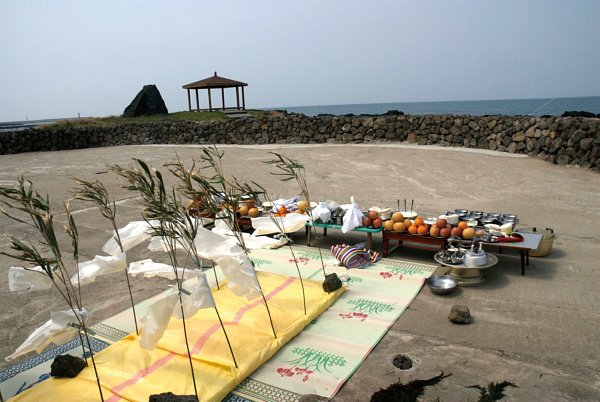 ▲ Photo courtesy Brenda Paik Sunoo, photojournalist and author of “Moon Tides [2011]
▲ Photo courtesy Brenda Paik Sunoo, photojournalist and author of “Moon Tides [2011]
The power, in this room filled with a hundred grandmothers, was palpable.
All talking at once, sitting on floor mats surrounding a long line of tables, many working together in a synchronous dance of food preparation, the collective strength of the “jamsu” – or diving women – was unquestionable.
Anticipation and camaraderie made for a festive atmosphere. A steady stream of village, city, and provincial officials stopped by, had a meal, and paid their respects to the gods, to the primary shaman and her supporting members, and perhaps above all, to the diving women.
This is Jamsu Gut, an annual shamanic rite to the gods to plea for a bountiful harvest and the health and safety of the divers.
[A note: the more familiar term of “haenyeo” is a recent lexical invention for tourism and means sea woman akin to mermaid; an older and more literally accurate term is “jamnyeo” or diving woman although the oldest and preferred term is jamsu – diving or diver.]
Distinct from the public Yeongdeung Gut, a ritual for the goddess of the sea and performed for both jamsu and fishermen, jamsu rituals are strictly for the diving women themselves. Only by special permission and with a compelling reason are a few outsiders able to attend.
All day, as the community of women celebrated, the shamans held rituals – first, a preliminary rite to invite and placate the spirits, by which to ensure a propitious ritual; then, a rite to pay respect to the gods who had joined them and ultimately, the primary multi-staged ritual itself.
This is Jamsu Gut, an annual shamanic rite to the gods to plea for a bountiful harvest and the health and safety of the divers.
[A note: the more familiar term of “haenyeo” is a recent lexical invention for tourism and means sea woman akin to mermaid; an older and more literally accurate term is “jamnyeo” or diving woman although the oldest and preferred term is jamsu – diving or diver.]
Distinct from the public Yeongdeung Gut, a ritual for the goddess of the sea and performed for both jamsu and fishermen, jamsu rituals are strictly for the diving women themselves. Only by special permission and with a compelling reason are a few outsiders able to attend.
All day, as the community of women celebrated, the shamans held rituals – first, a preliminary rite to invite and placate the spirits, by which to ensure a propitious ritual; then, a rite to pay respect to the gods who had joined them and ultimately, the primary multi-staged ritual itself.
 ▲ Photo courtesy Brenda Paik Sunoo, photojournalist and author of “Moon Tides [2011]
▲ Photo courtesy Brenda Paik Sunoo, photojournalist and author of “Moon Tides [2011]
Throughout this time, food production and consumption never ceased. The tables were laden with a vast array of the sea’s offerings as one could only expect at a jamsu celebration. Abalone and conch, sea urchin and its roe and a variety of sea vegetables were all represented in abundance.
Suh Sun-sil is the primary “simbang,” or shaman, of this ritual. She has been a shaman for the village of Gimnyeon for more than 30 years and her mother, now deceased, was its shaman before her.
Suh’s purpose is to act as intermediary between the jamsu and the gods. She tells the gods what the women need and in turn tells the women when the most and least propitious days are for diving, what concerns may arise, and how to avoid danger.
As any shaman, Suh serves as an emotional conduit as well. By her own description, she opens her “heart” completely during ritual and finds herself often overcome with emotion, even crying at times as she did on this day. She expressed gratitude for this experience and deems it cathartic for her as well as for the ritual participants.
Of the 100 or more women present, only about 20 sat in on the ritual itself. Others said it was important to attend the day’s event but not necessary to participate in the ritual. Still others cited the ritual as “for the grandmothers,” saying they were “too young” to be interested in it – and indicating that their time for shamanic ritual would come soon enough.
Two obvious elders, even in this tribe of women in which few were under the age of 50, sat chatting together. They were 91 and 94 years of age respectively, and while they are no longer diving, they retired not so long ago.
This – the ability to age with dignity intact and to remain engaged in life until the end – is the lesson of the jamsu to all of us.
The ritual lasted several hours and included many rites for honoring the gods and entreating their beneficence. But by its end, the shaman, her supporting members and the jamsu were showing not the least signs of fatigue.
The power of the so-called “Strong Jeju Woman” was never more obvious than in this setting. For the strength of Jeju’s women – whether diving women or not – is firmly grounded in community.
The shaman, tossing offerings into the sea, declared the upcoming harvest to be a bountiful one.

Dr. Anne Hilty is a Cultural Health Psychologist with a focus on the interplay of Eastern and Western theories of mental health as well as the mind-body connection. Her grounding is in the fields of cultural, transpersonal, and health psychology; she is additionally influenced by classical Chinese medicine, somatic psychology, and Asian shamanic traditions. Originally from the city of New York, Dr. Hilty lives on bucolic Jeju Island in South Korea, having previously lived in Seoul and Hong Kong.








